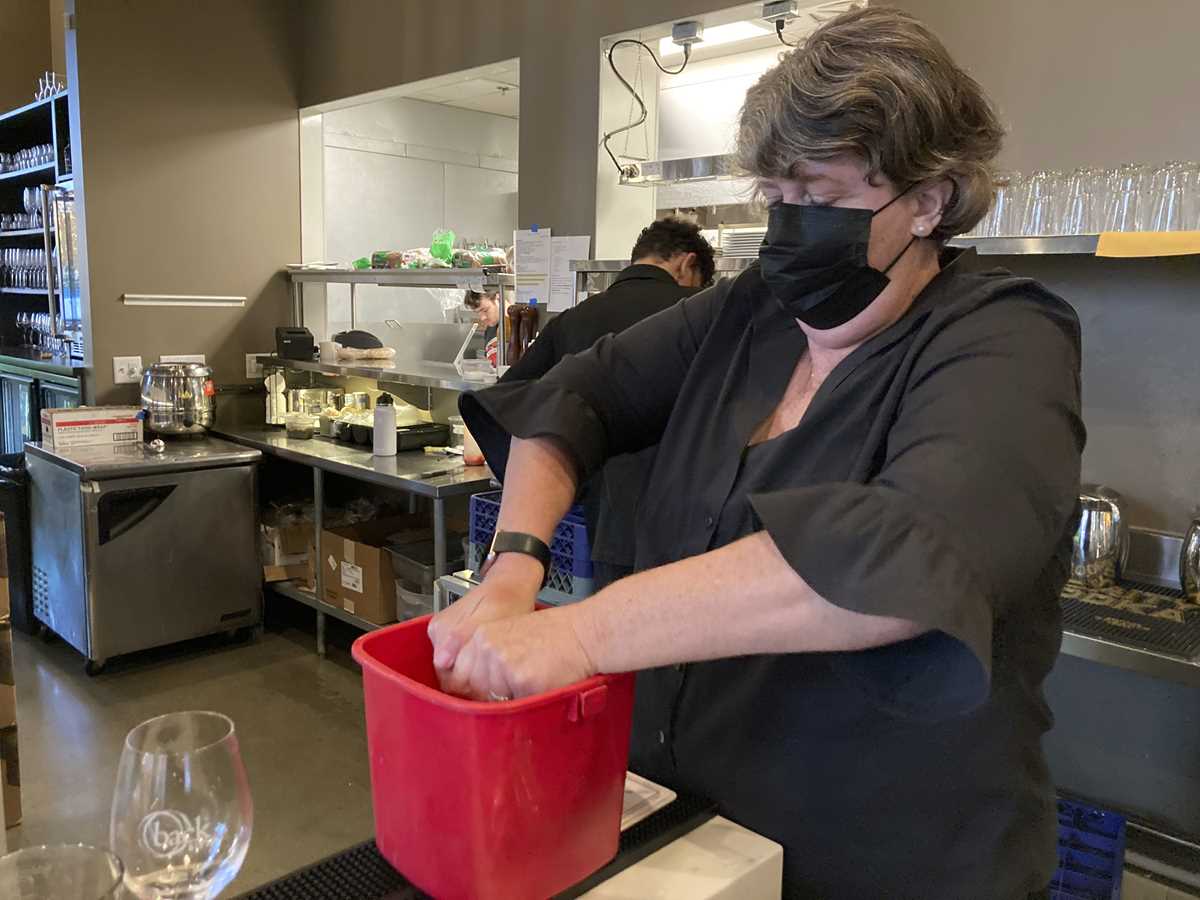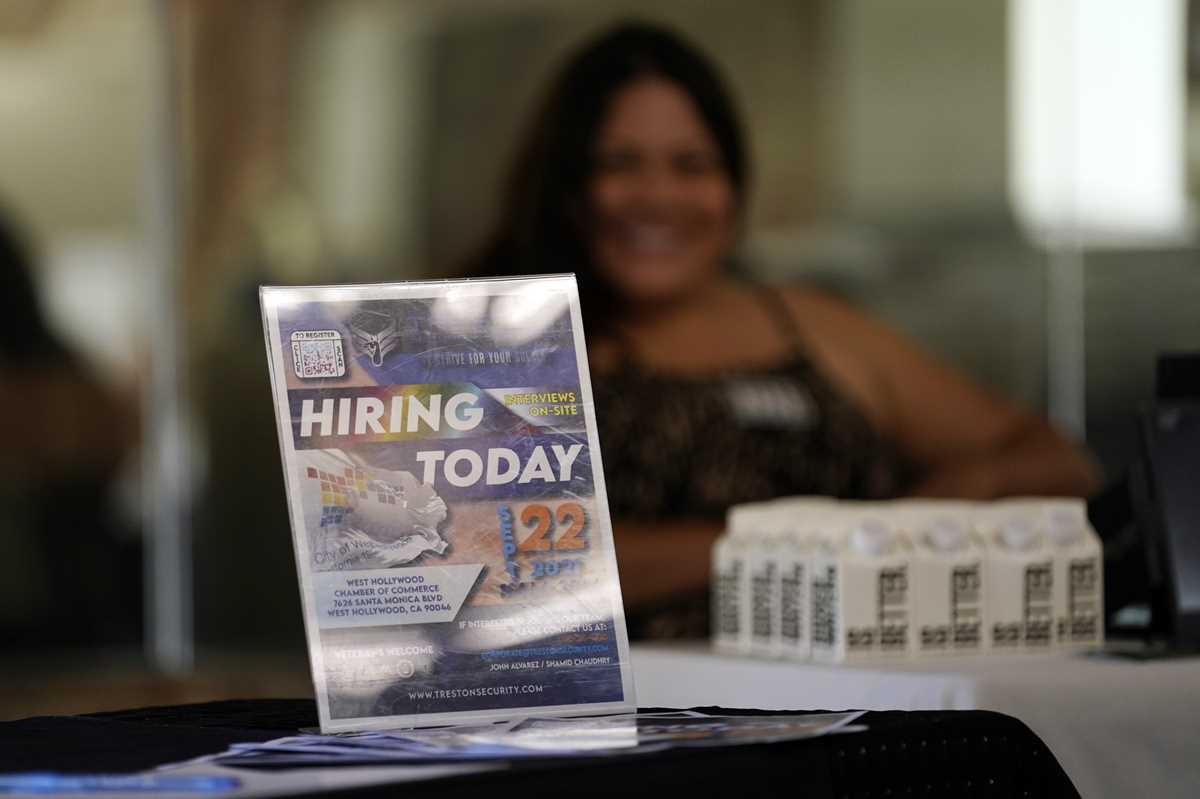 Folsom Vice Mayor Sarah Aquino wrings out a rag before cleaning a table at Back Bistro in Folsom, Calif., on Tuesday, Nov. 23, 2021. Aquino is an insurance broker. But she took a part-time job at one of her favorite local restaurants because they were struggling to hire people. Employers have reported a shortage of workers to meet demand as more people return to normal habits following the disruption of the coronavirus pandemic. Aquino sees it as her civic duty to help out local businesses. (AP Photo/Adam Beam)
Folsom Vice Mayor Sarah Aquino wrings out a rag before cleaning a table at Back Bistro in Folsom, Calif., on Tuesday, Nov. 23, 2021. Aquino is an insurance broker. But she took a part-time job at one of her favorite local restaurants because they were struggling to hire people. Employers have reported a shortage of workers to meet demand as more people return to normal habits following the disruption of the coronavirus pandemic. Aquino sees it as her civic duty to help out local businesses. (AP Photo/Adam Beam) A hiring sign is placed at a booth for prospective employers during a job fair Wednesday, Sept. 22, 2021, in the West Hollywood section of Los Angeles. Workers seeking a new career may face challenges if they’re looking to retrain, labor experts say. That’s because there are few social supports in place that allow career-change aspirants the time and financial help to do it. (AP Photo/Marcio Jose Sanchez, File)
A hiring sign is placed at a booth for prospective employers during a job fair Wednesday, Sept. 22, 2021, in the West Hollywood section of Los Angeles. Workers seeking a new career may face challenges if they’re looking to retrain, labor experts say. That’s because there are few social supports in place that allow career-change aspirants the time and financial help to do it. (AP Photo/Marcio Jose Sanchez, File)WASHINGTON (AP) — Inflation is surging. Supply chains are snarled. And yet economists predict that America's employers delivered another month of solid job growth in November on the strength of steady consumer spending.
Beneath the headline figures on hiring and unemployment, though, lurks a potentially even more consequential question: Are more people who lost jobs to the pandemic recession finally coming off the sidelines to look for work again? Many more job-seekers are needed to help companies fill their open jobs and sustain the economy's growth.
It's also a critical question for the Federal Reserve. If the proportion of people who either have a job or are looking for one doesn't rise much, it would suggest that the Fed is nearing its goal of maximum employment.
With inflation at a three-decade high and far above the Fed's 2% annual target, reaching its employment mandate would heighten pressure on Chair Jerome Powell to raise interest rates sooner rather than later. Doing so would make loans more expensive for many individuals and businesses.
Economists have forecast that employers added 535,000 jobs in November, nearly the same as October's 531,000 gain, according to data provider FactSet, and that the unemployment rate dipped from 4.6% to 4.5%. The Labor Department will issue the jobs report at 8:30 a.m. Eastern time Friday.
Even as the jobless rate has declined this year, the proportion of Americans who are working or looking for work has barely budged. A shortage of job-seekers tends to limit hiring and force companies to pay more to attract and keep employees. Higher pay can help sustain spending and growth. But it can also feed inflation if businesses raise prices to offset their higher labor costs, which they often do.
One result is that there are now 4.7 million fewer people with jobs than there were before the pandemic. Yet only about 1.7 million of them are actively looking for work and so are classified as unemployed. The remaining 3 million are no longer job-hunting and so aren't counted as unemployed. The government classifies people as unemployed only if they're actively seeking work.
So far this year, the unemployment rate has tumbled by about one-third, from 6.7% to 4.6%. Yet the proportion of people either working or looking for work has barely budged, from 61.5% to 61.6%.
About half the 3 million who have dropped out of the workforce have retired. The other half includes parents, mostly mothers, who stayed home to care for children during widespread closings of schools and day cares. For some of these women, child care remains unavailable or unaffordable. Some other people have become self-employed. And others continue to delay their job hunts for fear of contracting COVID-19.
Economists differ on the question of whether more people will soon resume their job hunts. Julia Pollak, a labor economist at ZipRecruiter, suggested that rising wages, a near-record level of open jobs and the declining unemployment rate provide encouraging signals for people still on the sidelines. By some measures, average wages are growing at their fastest pace in two decades.
“When it's sufficiently easy to find a job, more people take a swing at it,” Pollak said.
Other economists are less sure. Many of them, as well as Fed Chair Powell, had expected more women to return to the job market as schools reopened. That didn't happen, suggesting that some mothers might have decided to stay home permanently.
And before COVID, many older Americans came out of retirement to take jobs, often for social reasons or to keep busy. But with the coronavirus posing a particular threat to elderly people, far fewer retirees are returning to the workforce. With the emergence of the omicron variant, that hesitance could persist.
Omicron won't affect Friday's jobs report for November because the government gathered the data for it before that variant emerged. But omicron could exert an impact on the job market in future months.
Most gauges of the U.S. economy in November have been positive. Consumer spending surged, outpacing even inflation. Home sales rose in October at the fastest pace in January.
A survey of purchasing managers at factories found that new orders and production accelerated. There were even signs that supply chain snarls loosened a bit for some manufacturers.
Still, in many parts of the country, hiring remained difficult. In St. Louis, bus service was cut because the transit agency there couldn't find enough drivers.
Before you make your next trade, you'll want to hear this.
MarketBeat keeps track of Wall Street's top-rated and best performing research analysts and the stocks they recommend to their clients on a daily basis.
Our team has identified the five stocks that top analysts are quietly whispering to their clients to buy now before the broader market catches on... and none of the big name stocks were on the list.
They believe these five stocks are the five best companies for investors to buy now...
See The Five Stocks Here
MarketBeat's analysts have just released their top five short plays for May 2024. Learn which stocks have the most short interest and how to trade them. Click the link below to see which companies made the list.
Get This Free Report